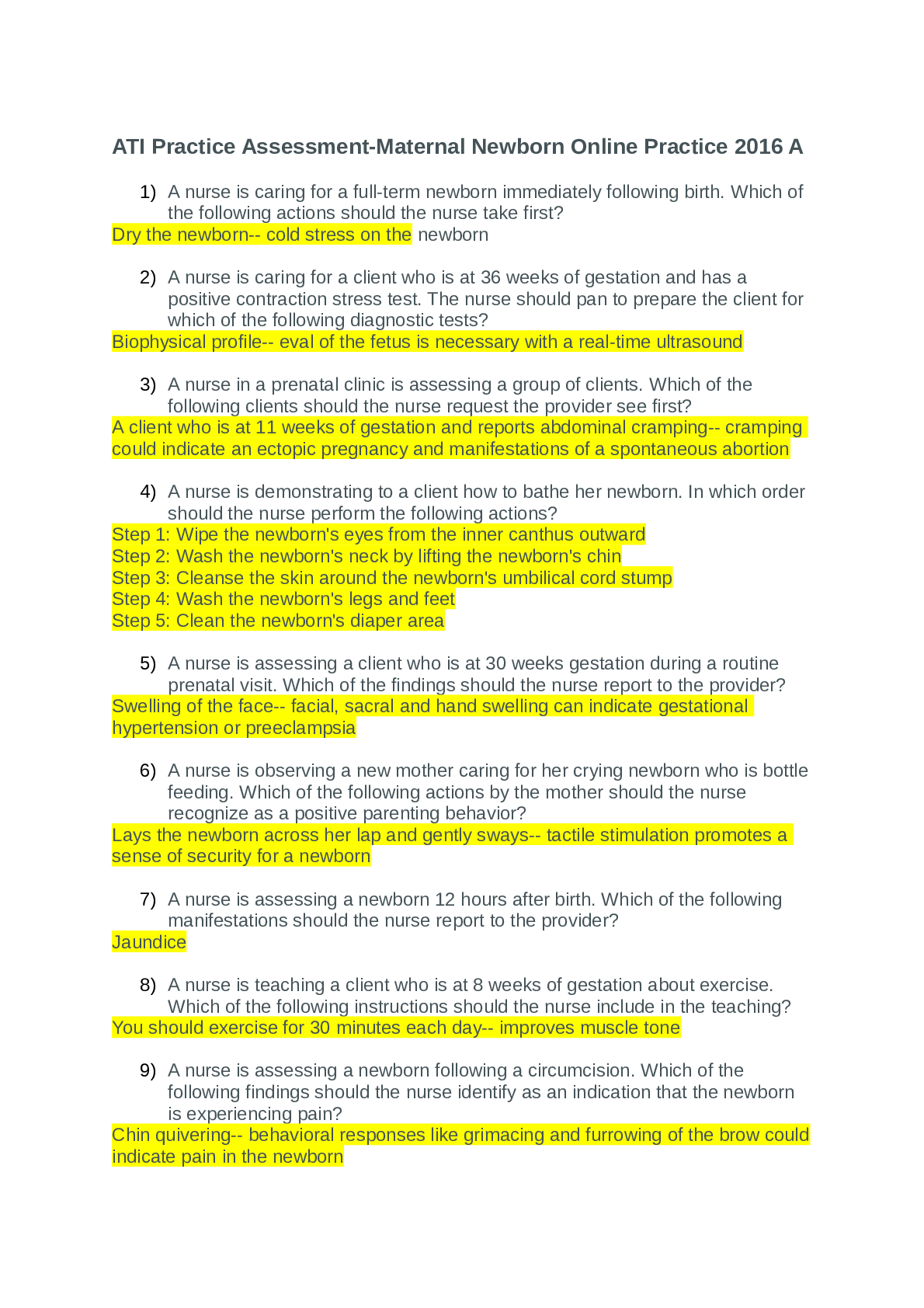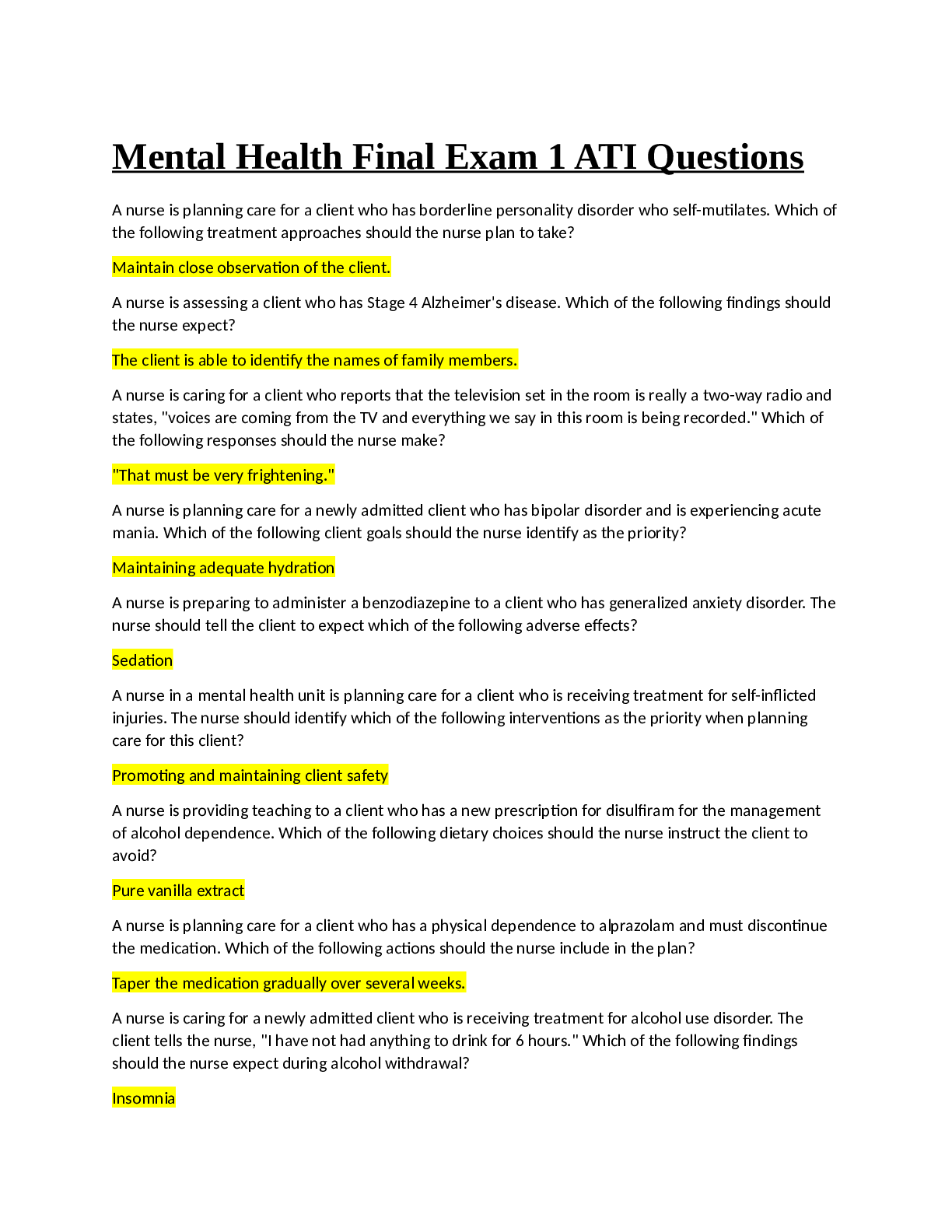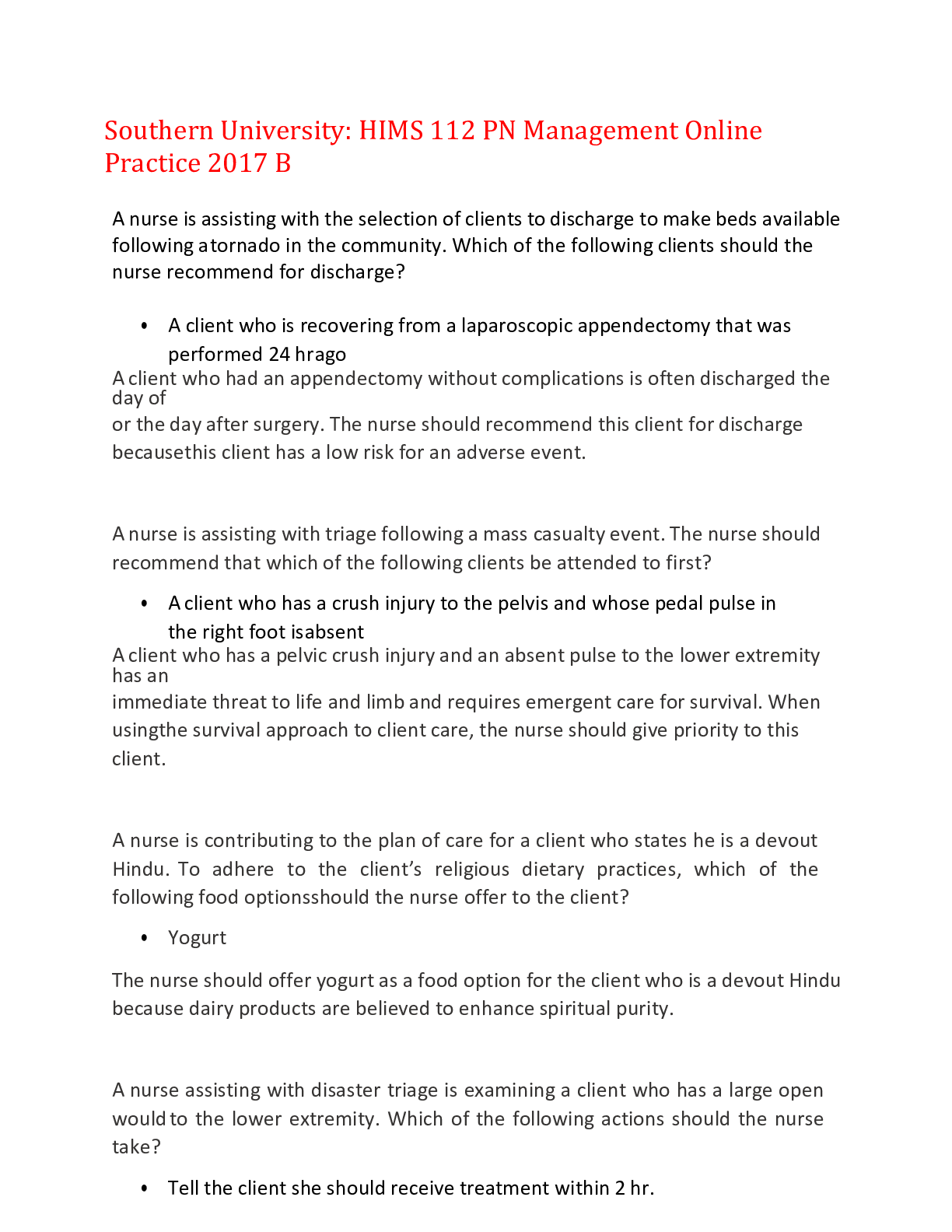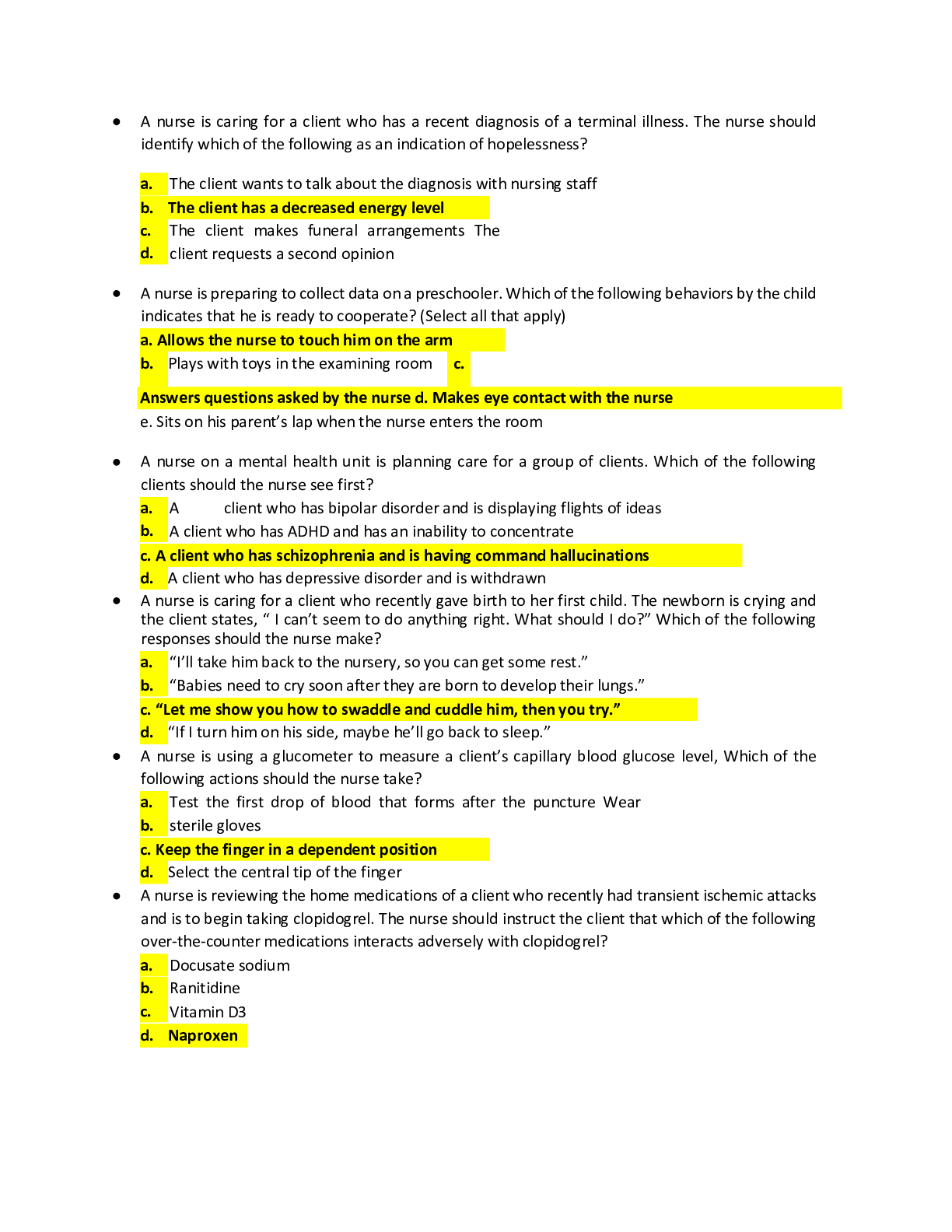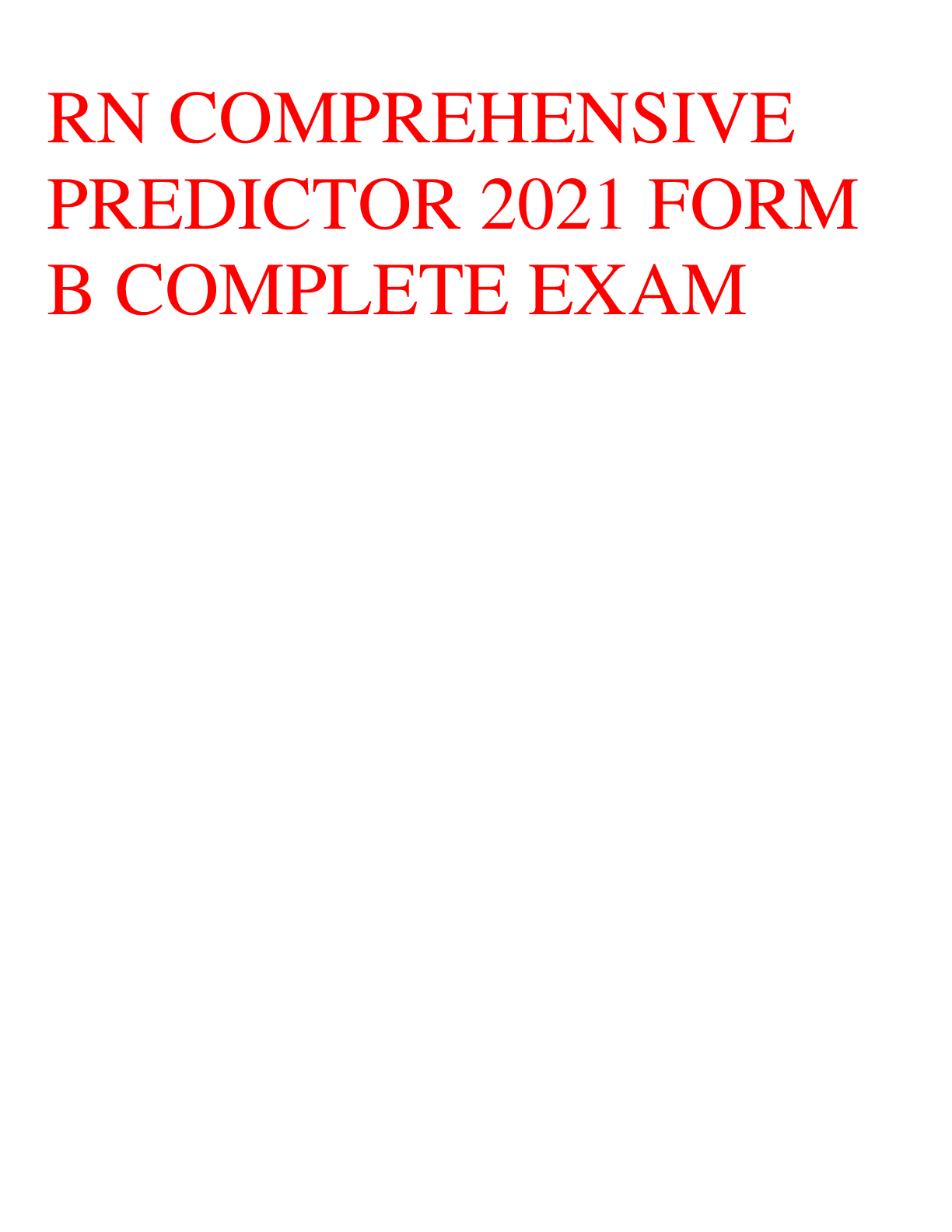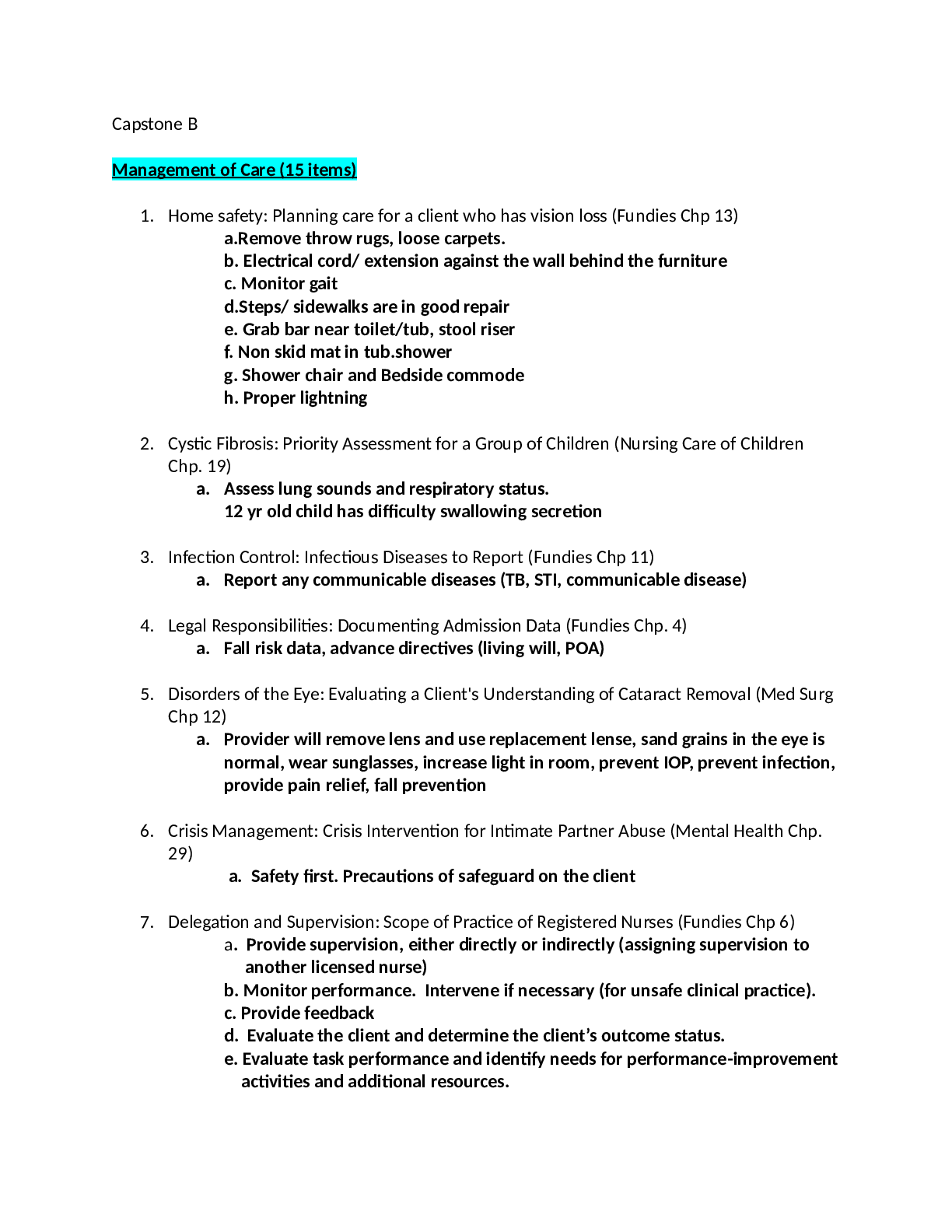*NURSING > QUESTIONS and ANSWERS > Galen College of Nursing MEDSURG 2 NUR 265 ATI OXYGENATION PRACTICE-8 QUESTIONS AND ANSWERS. (All)
Galen College of Nursing MEDSURG 2 NUR 265 ATI OXYGENATION PRACTICE-8 QUESTIONS AND ANSWERS.
Document Content and Description Below
1.A nurse is conducting a primary survey of a client who has sustained life-threatening injuries due to a motor-vehicle crash. Identify the sequence of actions the nurse should take. (Move the action... s into the box on the right, placing them in the selected order of performance. Use all the steps.) A. Perform a Glasgow Coma Scale assessment. B. Establish IV access. C. Open the airway using a jaw-thrust maneuver. D. Determine effectiveness of ventilator efforts. E. Remove clothing for a thorough assessment. 2.A nurse is caring for a client who has active pulmonary tuberculosis (TB) and is to be started on intravenous rifampin therapy. The nurse should instruct the client that this medication can cause which of the following adverse effects? A. Constipation B. Black colored stools C. Staining of teeth D. Body secretions turning a red-orange color 3.A nurse is caring for a client who has returned from the surgical suite following surgery for a fractured mandible. The client had intermaxillary fixation to repair and stabilize the fracture. Which of the following actions is the priority for the nurse to take? A. Prevent aspiration. B. Ensure adequate nutrition. C. Promote oral hygiene D. Relieve the client's pain. 4.A nurse caring for a client who has hypertension and asks the nurse about a prescription for propranolol. The nurse should inform the client that this medication is contraindicated in clients who have a history of which of the following conditions? A. Asthma B. Glaucoma Created on:08/03/2018 Page 1 Complex Oyxgenation ATI Practice C. Depression D. Migraines 5.A nurse is caring for a client who has acute respiratory distress syndrome (ARDS), and requires mechanical ventilation. The client receives a prescription for pancuronium. The nurse recognizes that this medication is for which of the following purposes? A. Decrease chest wall compliance B. Suppress respiratory effort C. Induce sedation D. Decrease respiratory secretions 6.A nurse is caring for a client who experienced a lacerated spleen and has been on bedrest for several days. The nurse auscultates decreased breath sounds in the lower lobes of both lungs. The nurse should realize that this finding is most likely an indication of which of the following conditions? A. An upper respiratory infection B. Pulmonary edema C. Atelectasis D. Delayed gastric emptying 7.A nurse is observing the closed chest drainage system of a client who is 24 hr post thoracotomy. The nurse notes slow, steady bubbling in the suction control chamber. Which of the following actions should the nurse take? A. Check the tubing connections for leaks. B. Check the suction control outlet on the wall. C. Clamp the chest tube. D. Continue to monitor the client's respiratory status. 8.A nurse is reviewing the laboratory findings for a client who developed fat embolism syndrome (FES) following a fracture. Which of the following laboratory findings should the nurse expect? A. Decreased serum calcium level B. Decreased level of serum lipids Created on:08/03/2018 Page 2 Complex Oyxgenation ATI Practice C. Decreased erythrocyte sedimentation rate (ESR) D. Increased platelet count 9.A nurse is caring for a client who is unconscious and has a breathing pattern characterized by alternating periods of hyperventilation and apnea. The nurse should document that the client has which of the following respiratory alterations? A. Kussmaul respirations B. Apneustic respirations C. Cheyne-Stokes respirations D. Stridor 10.A nurse is teaching a client who is obese and has obstructive sleep apnea how to decrease the number of nightly apneic episodes. Which of the following client statements indicates an understanding of the teaching? A. "It might help if I tried sleeping only on my back." B. "I'll sleep better if I take a sleeping pill at night." C. "I'll get a humidifier to run at my bedside at night." D. "If I could lose about 50 pounds, I might stop having so many apneic episodes." 11.A nurse is caring for a client who has a chest tube connected to a closed drainage system and needs to be transported to the x-ray department. Which of the following actions should the nurse take? A. Clamp the chest tube prior to transferring the client to a wheelchair. B. Disconnect the chest tube from the drainage system during transport. C. Keep the drainage system below the level of the client's chest at all times. D. Empty the collection chamber prior to transport. 12.A nurse is providing teaching to a client who is postoperative following coronary artery bypass graft (CABG) surgery and is receiving opioid medications to manage discomfort. Aside from managing pain, which of the following desired effects of medications should the nurse identify as most important for the client’s recovery? A. It decreases the client's level of anxiety. B. It facilitates the client's deep breathing. Created on:08/03/2018 Page 3 Complex Oyxgenation ATI Practice C. It enhances the client's ability to sleep. D. It reduces the client's blood pressure. 13.A nurse is assessing a client who has a pneumothorax with a chest tube in place. For which of the following findings should the nurse notify the provider? A. Movement of the trachea toward the unaffected side B. Bubbling of the water in the water seal chamber with exhalation C. Crepitus in the area above and surrounding the insertion site D. Eyelets are not visible 14.A nurse in an emergency department is caring for a client who has a sucking chest wound resulting from a gunshot. The client has a blood pressure of 100/60 mm Hg, a weak pulse rate of 118/min, and a respiratory rate of 40/min. Which of the following actions should the nurse take? A. Raise the foot of the bed to a 90° angle. B. Remove the dressing to inspect the wound. C. Prepare to insert a central line. D. Administer oxygen via nasal cannula. 15.A nurse is suctioning the endotracheal tube of a client who is on a ventilator. The client's heart rate increases from 86/min to 110/min and becomes irregular. Which of the following actions should the nurse take? A. Obtain a cardiology consult. B. Suction the client less frequently. C. Administer an antidysrhythmic medication. D. Perform pre-oxygenation prior to suctioning. 16.A nurse is caring for a client who is 1-day postoperative following a left lower lobectomy and has a chest tube in place. When assessing the client's three-chamber drainage system, the nurse notes that there is no bubbling in the suction control chamber. Which of the following actions should the nurse take? A. Continue to monitor the client as this is an expected finding. B. Add more water to the suction control chamber of the drainage system. Created on:08/03/2018 Page 4 Complex Oyxgenation ATI Practice C. Verify that the suction regulator is on and check the tubing for leaks. D. Milk the chest tube and dislodge any clots in the tubing that are occluding it. 17.A nurse in the post-anesthesia care unit is caring for a client who is postoperative following a thoracotomy and lobectomy. Which of the following postoperative assessments should the nurse give highest priority to? A. Arterial blood gases B. Urinary output C. Chest tube drainage D. Pain level 18.A client is admitted to the emergency room with a respiratory rate of 7/min. Arterial blood gases (ABG) reveal the following values. Which of the following is an appropriate analysis of the ABGs? pH 7.22 PaCO2 68 mm Hg Base excess -2 PaO2 78 mm Hg Saturation 80% Bicarbonate 26 mEq/L A. Respiratory acidosis B. Metabolic acidosis C. Metabolic alkalosis D. Respiratory alkalosis 19.A nurse is caring for four hospitalized clients. Which of the following clients should the nurse identify as being at risk for fluid volume deficit? A. The client who has been NPO since midnight for endoscopy. B. The client who has left-sided heart failure and has a brain natriuretic peptide (BNP) level of 600 pg/mL. C. The client who has end-stage renal failure and is scheduled for dialysis today. D. The client who has gastroenteritis and is febrile. 20.A nurse is assessing a client who has a fracture of the femur. The nurse obtains vital signs on admission and again in 2 hours. Which of the following changes in assessment should indicate to the nurse that the client could be developing a serious complication? A. Increased respiratory rate from 18 to 44/min. B. Increased oral temperature from 36.6° C (97.8° F) to 37° C (98.6° F). Created on:08/03/2018 Page 5 Complex Oyxgenation ATI Practice C. Increased blood pressure from 112/68 to 120/72 mm Hg. D. Increased heart rate from 68 to 72/min. 21.A nurse is developing a plan of care for a client who is postoperative. Which of the following interventions should the nurse include in the plan to prevent pulmonary complications? A. Perform range-of-motion exercises B. Place suction equipment at the bedside C. Encourage the use of an incentive spirometer D. Administer an expectorant 22.A nurse is caring for a client who is 12 hr postoperative and has a chest tube to a disposable water-seal drainage system with suction. The nurse should intervene for which of the following observations? A. Constant bubbling in the suction-control chamber B. Continuous bubbling in the water-seal chamber C. Bloody drainage in the collection chamber D. Fluid-level fluctuations in the water-seal chamber 23.A nurse is caring for a female client in the emergency department who reports shortness of breath and pain in the lung area. She states that she started taking birth control pills 3 weeks ago and that she smokes. Her heart rate is 110/min, respiratory rate 40/min, and blood pressure 140/80 mm Hg. Her arterial blood gases are pH 7.50, PaCO2 29 mm Hg, PaO2 60 mm Hg, HCO3 20 mEq/L, and SaO2 86%. Which of the following is the priority nursing intervention? A. Prepare for mechanical ventilation. B. Administer oxygen via face mask. C. Prepare to administer a sedative. D. Assess for indications of pulmonary embolism. 24.A nurse is monitoring a client following a thoracentesis. The nurse should identify which of the following manifestations as a complication and contact the provider immediately? A. Serosanguineous drainage from the puncture site Created on:08/03/2018 Page 6 Complex Oyxgenation ATI Practice B. Discomfort at the puncture site C. Increased heart rate D. Decreased temperature 25.A nurse is caring for a client whose arterial blood gas results show a pH of 7.3 and a PaCO2 of 50 mm Hg. The nurse should identify that the client is experiencing which of the following acid-base imbalances? A. Metabolic acidosis B. Metabolic alkalosis C. Respiratory acidosis D. Respiratory alkalosis 26.A nurse is caring for a client who has a chest tube in place to a closed chest drainage system. Which of the following findings should indicate to the nurse that the client's lung has re-expanded? A. Oxygen saturation of 95% B. No fluctuations in the water seal chamber C. No reports of pleuritic chest pain D. Occasional bubbling in the water-seal chamber 27.A nurse is monitoring a client who has a chest tube in place connected to wall suction due to a right-sided pneumothorax. The client complains of chest burning. Which of the following actions should the nurse take? A. Increase the client’s wall suction. B. Strip the client’s chest tube. C. Clamp the client’s chest tube. D. Reposition the client. 28.A nurse is caring for a client who has returned to the unit following a surgical procedure. The client’s oxygen saturation is 85%. Which of the following actions should the nurse take first? A. Administer oxygen at 2 L/min. B. Administer prescribed analgesic medication. Created on:08/03/2018 Page 7 Complex Oyxgenation ATI Practice C. Encourage coughing and deep breathing. D. Raise the head of the bed. 29.A nurse is preparing to measure a client’s level of oxygen saturation and observes edema of both hands and thickened toe nails. The nurse should apply the pulse oximeter probe to which of the following locations? A. Finger B. Earlobe C. Toe D. Skin fold 30.A nurse is caring for a client who has pneumonia. Which of the following actions should the nurse take to promote thinning of respiratory secretions? A. Encourage the client to ambulate frequently. B. Encourage coughing and deep breathing. C. Encourage the client to increase fluid intake. D. Encourage regular use of the incentive spirometer. 31.A nurse is caring for a client who has a central venous catheter and develops acute shortness of breath. Which of the following actions should the nurse take first? A. Clamp the catheter. B. Position the client in left lateral Trendelenburg. C. Initiate oxygen therapy. D. Auscultate breath sounds. 32.A nurse is caring for a client who has a disposable three-chamber chest tube in place. Which of the following findings should indicate to the nurse that the client is experiencing a complication? A. Continuous bubbling in the water-seal chamber B. Occasional bubbling in the water-seal chamber C. Constant bubbling in the suction-control chamber Created on:08/03/2018 Page 8 Complex Oyxgenation ATI Practice D. Fluctuations in the fluid level in the water-seal chamber 33.A nurse is prioritizing client care after receiving change-of-shift report. Which of the following clients should the nurse plan to see first? A. A client who is scheduled for an abdominal x-ray and is awaiting transport B. A client who has a prescription for discharge C. A client who received oral pain medication 30 min ago D. A client who told an assistive personnel he is short of breath 34.A nurse is caring for a client who is postoperative following surgical repair of a mandibular fracture with fixed occlusion of the jaws in a closed position. Which of the following statements is the priority for the nurse to make? A. "We can teach you some relaxation techniques to minimize your pain." B. "Keep wire cutters with you at all times." C. "Use a water pick device to keep your teeth clean." D. "Consume a high-protein, liquid diet." 35.A nurse is caring for a client who experienced a femur fracture 8 hr ago and now reports sudden onset dyspnea and severe chest pain. Which of the following actions should the nurse take first? A. Provide high-flow oxygen. B. Check the client for a positive Chvostek's sign. C. Administer an IV vasopressor medication. D. Monitor the client for headache. 36.A nurse in the PACU is assessing a client who has an endotracheal tube (ET) tube in place and observes the absence of left-sided chest wall expansion upon respiration. Which of the following complications should the nurse suspect? A. Blockage of the ET tube by the client's tongue B. Passage of the ET tube into the esophagus C. Movement of the ET tube into the right main bronchus Created on:08/03/2018 Page 9 Complex Oyxgenation ATI Practice D. Infection of the vocal cords 37.A nurse is caring for a client who is postoperative and whose respirations are shallow and 9/min. Which of the following acid-based imbalances should the nurse identify the client as being at risk for developing initially? A. Respiratory acidosis B. Respiratory alkalosis C. Metabolic acidosis D. Metabolic alkalosis 38.A nurse is planning care for a client who has acute respiratory distress syndrome (ARDS). Which of the following interventions should the nurse include in the plan? A. Administer low-flow oxygen continuously via nasal cannula. B. Encourage oral intake of at least 3,000 mL of fluids per day. C. Offer high-protein and high-carbohydrate foods frequently. D. Place in a prone position. 39.A nurse is assessing a client who has developed atelectasis postoperatively. Which of the following findings should the nurse expect? A. Facial flushing B. Increasing dyspnea C. Decreasing respiratory rate D. Friction rub 40.A nurse is caring for a client who has just developed a pulmonary embolism. Which of the following medications should the nurse anticipate administering? A. Furosemide B. Dexamethasone C. Heparin D. Atropine Created on:08/03/2018 Page 10 Complex Oyxgenation ATI Practice 41.A nurse is caring for a client who develops a pulmonary embolism. Which of the following interventions should the nurse implement first? A. Give morphine IV. B. Administer oxygen therapy. C. Start an IV infusion of lactated Ringer's. D. Initiate cardiac monitoring. 42.A nurse is assessing a client who has postoperative atelectasis and is hypoxic. Which of the following manifestations should the nurse expect? A. Bradycardia B. Bradypnea C. Lethargy D. Intercostal retractions 43.A nurse is assessing a client immediately after the provider removed the client's endotracheal tube. Which of the following findings should the nurse report to the provider? A. Stridor B. Copious oral secretions C. Hoarseness D. Sore throat 44.A nurse in the emergency department is caring for a client who was injured in a motor-vehicle crash. The client reports dyspnea and severe pain. The nurse notes that the client's chest moves inward during inspiration and bulges out during expiration. The nurse should identify this finding as which of the following? A. Atelectasis B. Flail chest C. Hemothorax D. Pneumothorax Created on:08/03/2018 Page 11 Complex Oyxgenation ATI Practice 45.A nurse is auscultating the lungs of a client who has pleurisy. Which of the following adventitious breath sounds should the nurse expect to hear? A. Loud, scratchy sounds B. Squeaky, musical sounds C. Popping sounds D. Snoring sounds 46.A nurse in the emergency department is caring for a client who has pulmonary edema, reports dyspnea, and appears anxious. The client's blood pressure is 108/79 and his apical pulse is 112. Which of the following interventions is the nurse's priority? A. Administer high-flow oxygen at 5 L/min by facemask to the client. B. Place the client in high-Fowler's position with legs dependent. C. Give the client sublingual nitroglycerin. D. Reassure the client. 47.A nurse is monitoring an older adult client immediately following a bronchoscopy. The nurse's priority is to monitor the client for which of the following? A. Observing for confusion B. Auscultating breath sounds C. Confirming the gag reflex D. Measuring blood pressure 48.A nurse in the emergency department is assessing an older adult client who has community- acquired pneumonia. Which of the following findings should the nurse expect? A. Unequal pupils B. Hypertension C. Tympany upon chest percussion D. Confusion Created on:08/03/2018 Page 12 Complex Oyxgenation ATI Practice 49.A nurse in the intensive care unit is providing teaching for a client prior to removal of an endotracheal tube. Which of the following instructions should the nurse include in the teaching? A. "Rest in a side-lying position after the tube is removed." B. "Use the incentive spirometer every 4 hr after the tube is removed." C. "Avoid speaking for long periods." D. "A nurse will monitor your vital signs every 15 minutes in the first hour after the tube is removed." 50.A nurse is caring for a client who is receiving mechanical ventilation and has an ideal weight of 60 kg. The nurse should expect the tidal volume to be set at which of the following? A. 300 mL B. 480 mL C. 800 mL D. 950 mL 51.A nurse is caring for a client who has an acute respiratory failure (ARF). The nurse should monitor the client for which of the following manifestations of this condition? (Select all that apply.) A. Severe dyspnea B. Nausea C. Decreased level of consciousness D. Headache E. Hypotension 52.A nurse is triaging victims of a multiple motor-vehicle crash. The nurse assesses a client trapped under a car who is apneic and has a weak pulse at 120/min. After repositioning his upper airway, the client remains apneic. Which of the following actions should the nurse take? A. Start CPR. B. Place a red tag on the client's upper body and obtain immediate help from other personnel. C. Place a black tag on the client's upper body and attempt to help the next client in need. D. Reposition the client's upper airway a second time before assessing his respirations. Created on:08/03/2018 Page 13 Complex Oyxgenation ATI Practice 53.A charge nurse is reviewing guidelines for initiating airborne precautions. Which of the following clients should the nurse identify as requiring airborne precautions? A. A client who has scabies B. A client who has pertussis C. A client who has streptococcal pharyngitis D. A client who has measles 54.A nurse is monitoring a client who received epinephrine for angioedema after a first dose of losartan. Which of the following data indicates a therapeutic response to the epinephrine? A. Respirations are unlabored. B. Client reports decreased groin pain of 3 on a 1 to 10 scale. C. The client's blood pressure when arising from resting position is at premedication levels. D. The client tolerates a second dose of medication with no greater than 1+ peripheral edema. 55.A nurse is reviewing the arterial blood gas results for a client in the ICU who has kidney failure and determines the client has respiratory acidosis. Which of the following findings should the nurse expect? A. Widened QRS complexes B. Hyperactive deep tendon reflexes C. Bounding peripheral pulses D. Warm, flushed skin 56.A nurse is caring for a client who has a three-chamber closed chest tube system. Which of the following actions should the nurse take after noticing a rise in the water seal chamber with client inspiration? A. Continue to monitor the client. B. Immediately notify the provider. C. Reposition the client toward the left side. D. Clamp the chest tube near the water seal. Created on:08/03/2018 Page 14 Complex Oyxgenation ATI Practice 57.A nurse is caring for a client who is receiving positive-pressure mechanical ventilation. Which of the following interventions should the nurse implement to prevent complications? (Select all that apply.) A. Elevate the head of the bed to at least 30°. B. Verify the prescribed ventilator settings daily. C. Apply restraints if the client becomes agitated. D. Administer pantoprazole as prescribed. E. Reposition the endotracheal tube to the opposite side of the mouth daily. 58.A nurse is assessing a client who is 1 day postoperative following a lobectomy and has a chest tube drainage system in place. Which of the following findings by the nurse indicates a need for intervention? A. Chest tube eyelets not visible B. Continuous bubbling in the suction control chamber C. Presence of tidal fluctuation in the water seal chamber D. Development of subcutaneous emphysema 59.A nurse is reviewing the laboratory values of a client who has respiratory acidosis. Which of the following findings should the nurse expect? A. HCO3- 30 mEq/L B. PaCO2 50 mm Hg C. pH 7.45 D. Potassium 3.3 mEq/L 60.A nurse is caring for a client who has an endotracheal tube and is receiving mechanical ventilation. Which of the following interventions should the nurse take to reduce the risk for ventilator-associated pneumonia? A. Position the head of the client's bed in the flat position. B. Turn the client every 4 hr. C. Rinse the client's mouth with an antimicrobial solution every 4 hr. D. Perform hand hygiene prior to suctioning the client's endotracheal tube. Created on:08/03/2018 Page 15 Complex Oyxgenation ATI Practice 61.A nurse is caring for a client who has an endotracheal tube and is receiving mechanical ventilation. The client pulls out his endotracheal tube. Which of the following actions should the nurse take first? A. Prepare the client for reintubation. B. Assess the client’s airway. C. Suction the client’s mouth. D. Elevate the client’s head of bed. 62.A nurse is caring for a child who is experiencing status asthmaticus. Which of the following interventions is the priority for the nurse to take? A. Administer a short-acting ß2 –agonist (SABA). B. Obtain a peak flow reading. C. Administer an inhaled glucocorticoid. D. Determine the cause of the acute exacerbation. 63.A nurse is assessing a client for hypoxemia during an asthma attack. Which of the following manifestations should the nurse expect? A. Nausea B. Dysphagia C. Agitation D. Hypotension 64.A nurse is teaching a client about taking diphenhydramine. The nurse should explain to the client that which of the following is an adverse effect of this medication? A. Sedation B. Constipation C. Hypertension D. Bradycardia. 65.A nurse is performing chest physiotherapy on a client who has a respiratory infection. To increase the velocity and Created on:08/03/2018 Page 16 Complex Oyxgenation ATI Practice turbulence of the air the client exhales, which of the following techniques should the nurse use? A. Postural drainage B. Nebulization C. Percussion [Show More]
Last updated: 1 year ago
Preview 1 out of 17 pages
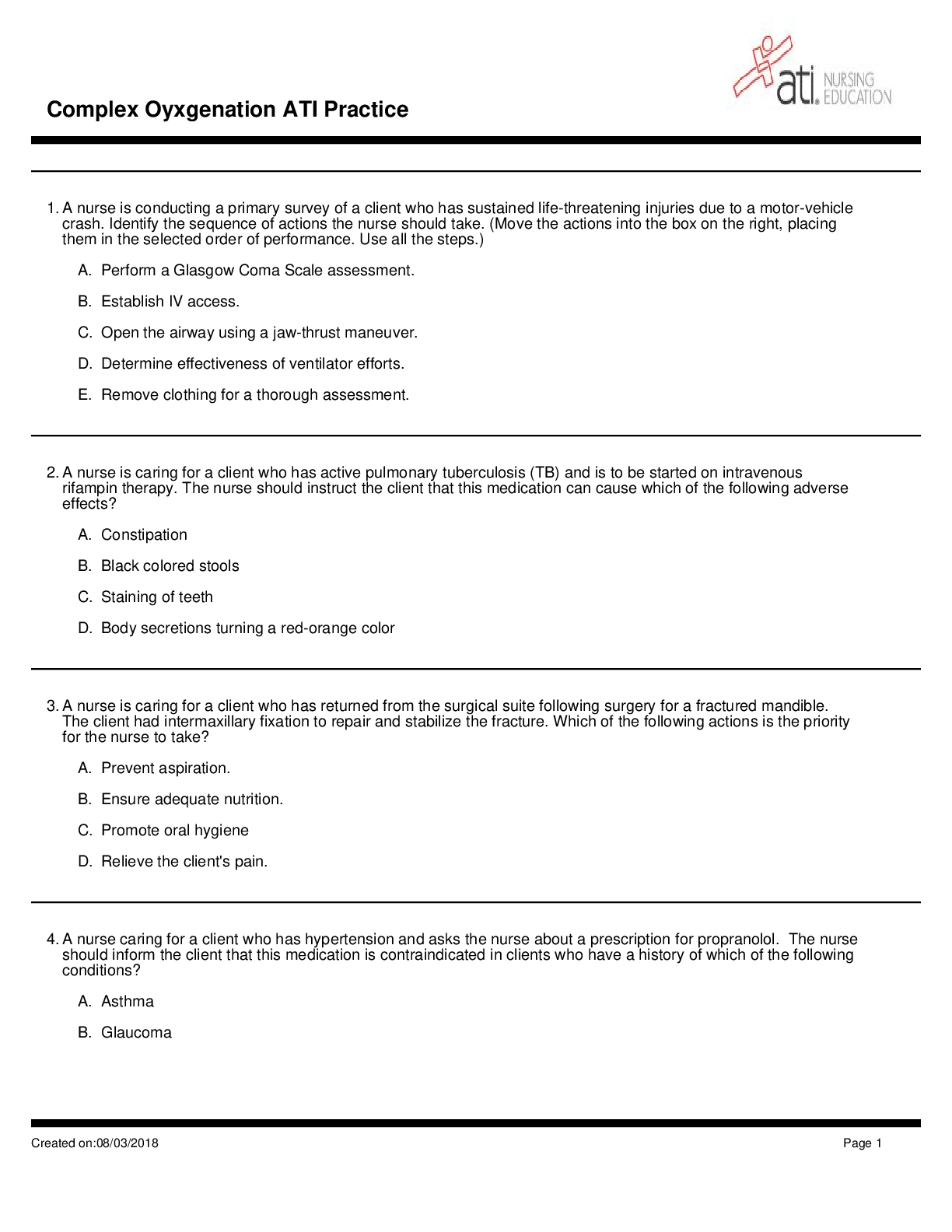
Reviews( 0 )
Document information
Connected school, study & course
About the document
Uploaded On
Feb 19, 2021
Number of pages
17
Written in
Additional information
This document has been written for:
Uploaded
Feb 19, 2021
Downloads
0
Views
165


